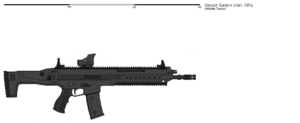Infantry Combat Rifle
| Infantry Combat Rifle | |
|---|---|
 The ICR-L, chambered in 6.8 mm Munmu rounds. | |
| Type | assault rifle |
| Place of origin | |
| Service history | |
| In service | 2004 to present |
| Used by | see "Users" |
| Production history | |
| Designer | Shinjin Technologies |
| Designed | 1994-2003 |
| Manufacturer | Shinjin Technologies, Signus Systems |
| Produced | 2004 - Present |
| No. built | 900,000+ |
| Variants | see below |
| Specifications (ICR-L standard) | |
| Weight | 3.5 kg without magazine 3.9 kg with 30rnd magazine |
| Length | 881 mm |
| Barrel length | 318 mm |
| Width | 81 mm |
| Cartridge | 6.8 mm Munmu (ICR-L) 7.62 x 51 mm NATO (ICR-H) .300 blackout (ICR-S) |
| Action | Short-stroke piston, rotating bolt |
| Rate of fire | 800 rpm |
| Muzzle velocity | 900 m/s |
| Effective firing range | 600 m |
| Maximum firing range | 900 m |
| Feed system | 20, 30 or 40-round detachable box magazine or 100-round drum magazine (optional) |
| Sights | Adjustable iron sights Picatinny rail for attaching various optics |
The Infantry Combat Rifle (ICR) (Zhenian: 보병전투소총), formerly known as the Next-Generation Infantry Weapon (Zhenian: 차세대보병화기) during its development phase, is a line of Template:Short-stroke piston-operated, selective-fire assault rifles with a rotating bolt from Zhenia. Constructed to be a modular rifle, it features high modularity in barrel and caliber changes, as well as its adaptability to various circumstances all while using the same platform. Like its predecessor, the Z620 series, its initial baseline variant, the ICR-L, was developed with the Munmu 6.8 mm rounds in mind, although other variants using different calibers exist. Introduced in 2004, it has been designated as the primary service rifle of the Greater Eastern Union Defense Forces since then.